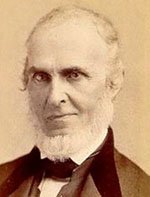Who Is Whittier and Why Does He Have a "Place" on Campus?
Recently, I've had a couple of people ask me just who was that bearded man whose portrait hangs in the Whittier Room, and who is the namesake of the College's Whittier Place, now home of the Lang Center for Civic and Social Responsibility. A brief answer is that he is John G. Whittier (1807-1892), one of America's best known poets of the 19th century. His poems, mostly those about rural New England such as "The Barefoot Boy" and "Snowbound" are still a staple in historical anthologies of American poetry.

Unfortunately for Whittier, literary reputations rise and fall, and at this point, Whittier is not so well regarded as he was in his lifetime. Since Friends Historical Library (FHL) holds an extensive collection of Whittier's writings, both published and manuscript, we can always hope for a Whittier revival.
Whittier was also a Quaker and an abolitionist. His 1833 pamphlet, "Justice and Expediency," called for the immediate abolition of slavery - a radical proposal in that day - and later that year, Whittier, with his old friend William Lloyd Garrison, was a major figure in the establishment of the American Anti-Slavery Society. Lucretia and James Mott, counted among the College's founders, were also founders with Whittier and Garrison of the American Anti-Slavery Society.
Whittier wrote pamphlets and poems against slavery and edited anti-slavery periodicals. He faced mobs at Concord, New Hampshire, in 1835 and at Philadelphia in 1838, when the mob burned down Pennsylvania Hall, a building specifically built for the advocacy of abolition and for free discussion. At the time, Whittier was editor of the Pennsylvania Freeman.
One theme of Whittier's anti-slavery poetry was the shared responsibility of all Americans for the evils of slavery:
What, ho! /our /countrymen in chains!
The whip on woman's shrinking flesh!
/Our /soil yet reddening with the stains
Caught from her scourging, warm and fresh!
What! Mothers from their children riven!
What! God's own image bought and sold!
Americans to market driven,
And bartered as the brute for gold!
Another theme was the duty to do something about it:
To thy duty now and ever!
Dream no more of rest or stay;
Give to Freedom's great endeavor
All thou art and hast today.
I might suggest that when Whittier Place and the Whittier Room were named, what was on people's minds was not so much the Quaker poet who wrote nostalgic verses recollecting his impoverished New England childhood. Instead, it was the Whittier who as a young man in the 1820s took up the then-highly unpopular cause of abolition and carried it forward for three decades and more.


